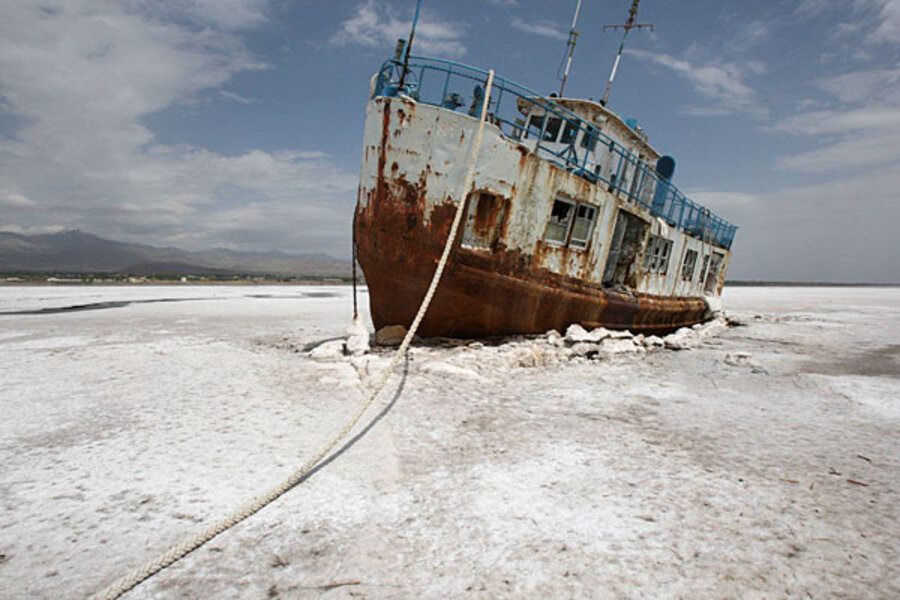Global warming: Middle East's vital wet winters are disappearing
Loading...
Winter droughts have become increasingly common in the Mediterranean region, particularly over the past 20 years, and a new study finds that global warming has driven at least half of the change.
Drought conditions in this politically explosive region are expected to grow more severe over the course of the century unless countries begin to significantly reduce their emissions of heat-trapping greenhouse gases, particularly carbon dioxide, many researchers say.
Those emissions come from burning fossil fuels, as well as from land-use changes.
Winter storms historically have delivered most of the annual rain and snowfall to the already arid Mediterranean region. Yet precipitation measurements from the region and modeling studies point to a relatively rapid shift in the winter rain and snowfall trends that began in the 1970s, according to the study.
That change could signal that the region "has moved into a new climate regime," says Martin Hoerling, a scientist at the National Oceanic and Atmospheric Administration's Earth Systems Research Laboratory in Boulder, Colo., and the study's lead author.
The shift is not the result of temperature trends in the region itself, Dr. Hoerling notes. Instead, he and his colleagues trace drier Mediterranean winters to changes in long-range atmospheric circulation patterns. These changes, the study suggests, are triggered by rising ocean temperatures in the tropical Indian Ocean, a trend scientists have previously attributed to climate change.
When this area of the world's oceans is warmer than other tropical seas, the temperature difference appears to set up conditions over the North Atlantic that steer a higher proportion of Atlantic winter storms across northern Europe.
The results have been accepted for publication in the Journal of Climate.
The study reaches "a very important conclusion, for a number of reasons," says Peter Gleick, president of the Pacific Institute, a environmental-policy research group in Oakland, Calif., that focuses much of its effort on water-resource issues.
From 60 to 80 percent of the region's water irrigates crops, researchers say. And existing sources of fresh water already are oversubscribed.
"Water is critical for this region and has been for a long time," Dr. Gleick says. "The fact that climate change now appears to be making things worse or more severe is just more bad news for people who care about water conflicts and water scarcity in the Middle East."
In addition, he says, the study adds to a growing body of work that is finding global warming responsible – at least in part – for long-term changes in precipitation and temperature patterns at continental and even regional scales.
"We know that climate is changing. We know that humans are an important factor," he says. "But unless you can say, 'this or that event is due to climate change or partly due to climate change,' there's a lack of a sense of urgency."
Hoerling says he and his team were drawn to look at the Mediterranean region following the publication in 2007 of the latest snapshot of the state of climate science from the UN-sponsored Intergovernmental Panel on Climate Change.
Modeling studies included in the three main volumes pointed to the Mediterranean as one of several regions where the effects of global warming would be most pronounced as climate warmed during the 21st century. It became known as a global-warming hot spot, based on projections of an ever-drier regional climate.
The team looked at precipitation records gathered by four research groups based in the US, Britain, and Germany. The data the team used covers 110 years, beginning in 1901. While the records had gaps, they told a similar story. The team estimates that average precipitation from November through April in the region between 1971 and 2010 fell 6.8 percent below the average from 1902 to 1970.
The team began the hunt for causes.
The wetter north, drier south is similar to the pattern that sets up during one phase of a see-saw atmospheric shift over the North Atlantic called the North Atlantic Oscillation.
It's most pronounced in winter, and affects trans-Atlantic storm tracks. But when the team looked at records for the feature and ran modeling studies of 20th century climate, the team could only find a weak long-term shift in the feature that would reinforce the north-south rain and snowfall difference. The shift, however, wasn't nearly enough to account for the drying underway in the Mediterranean region.
At the same time, Hoerling says, he hearkened back to work he and colleagues had done some years before showing a link between sea-surface temperatures in the Indian Ocean and shifts in the North Atlantic Oscillation toward a phase that dries out the Mediterranean in winter.
As a consequence of global warming, ocean surface temperatures have warmed since 1900, he says. The team began using computer models to assess the effect of this ocean warming on the Mediterranean's winter precipitation.
The team found that warming all the oceans by a uniform 0.5 degrees Celsius (about 1 degree Fahrenheit) would dry out the eastern Mediterranean.
But the oceans haven't warmed uniformly. The greatest warming has come to tropical oceans. So the team focused next on warming the tropical oceans uniformly in their virtual world. The team got a Mediterranean-wide drying and a wetter northern Europe.
Still, neither of these experiments produced the strong positive North Atlantic Oscillation-like signal with enhanced drying to the south and heavier precipitation to the north.
But by adding another 0.5 degrees C to the Indian Ocean alone, model produced the strong north-south differences in precipitation associated with a positive phase of the North Atlantic Oscillation.
The group acknowledges that the work contains uncertainties, but the results appear to be strong enough to tie global warming's effect on the tropical oceans in general and the tropical Indian Ocean in particular to the enhanced drying trend the Mediterranean region has experienced, they say.





